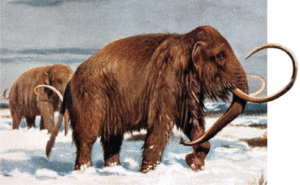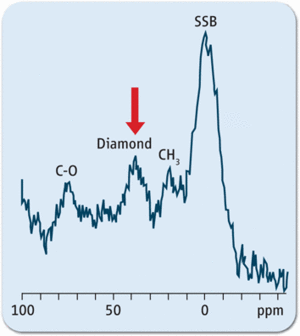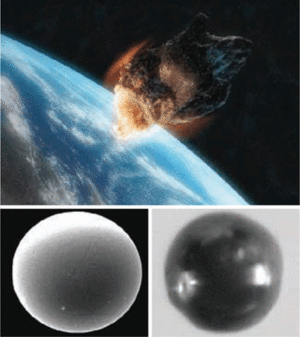
|
| ©GIANNI DAGLI ORTI/CORBIS |
| Victims of a hit? Published evidence that an impact triggered the mammoths' disappearance is falling far short of proof. |
It looked impressive as slide after data-laden slide flashed on the screen last spring. Nearly a dozen debris markers, found at 26 sites from the U.S. West Coast to Belgium, testified to a huge impact followed by a continent-spanning wildfire. The catastrophe had taken place a geologic instant ago--closely coinciding with the disappearance of North America's mammoths and the continent's earliest human culture (Science, 1 June 2007, p. 1264). Then came the 26-author paper last October in the Proceedings of the National Academy of Sciences (PNAS), not to mention the hourlong National Geographic Channel documentary running on cable since last October, with more coverage on the way from the History Channel and PBS's prestigious program NOVA.
Although cosmically blasted mammoths may make good copy, many impact specialists have lately swung from leeriness to thorough disbelief. "The whole thing is contrived," says geochemist and impact specialist Christian Koeberl of the University of Vienna, Austria. "Their data don't agree with anything we know about impacts. It just doesn't make any sense. Occam's razor has been put safely in a drawer somewhere."
One problem is that no one has "any of the classic evidence of an impact," says impact specialist David Kring of the Lunar and Planetary Institute in Houston, Texas. Spurred by the 1980s debate over what killed off the dinosaurs, "the community learned a lot about what the threshold of evidence is" for confirming an impact, he explains. But taking all the evidence offered by the group proposing the mammoth-killer impact, "you end up with [markers] that are not diagnostic of impact," says impact specialist Bevan French of the National Museum of Natural History in Washington, D.C. Proponents, meanwhile, are defending some of their published claims and giving ground on others but promising ultimate vindication.
Diamonds not forever
Everyone agrees on one point at least. "Obviously, something really interesting happened 13,000 years ago," as Kring puts it. It was 12,900 years ago, to be precise, that a world staggering out of the last Ice Age suddenly plunged back into a millennium of near-glacial climate before emerging into the current warmth. It was also about then--emphasis on the uncertainties summed up by "about"--that the mammoths and other great beasts disappeared from North America. And the Paleo-Indian Clovis culture vanished from the archaeological record around then, too.
The PNAS authors have a cosmic explanation for the coincidence of climate shift, extinctions, and cultural oblivion: A body or clump of bodies from outer space ravaged North America. By exploding over or actually hitting the great ice sheet in the north, their reasoning goes, the impactors could have shifted climate into the chill of the so-called Younger Dryas (YD) period. And the blast or blasts, as well as the resulting continent-wide wildfire, would have sufficed to wipe out or at least seriously weaken man and beast.
Headed by nuclear chemist Richard Firestone of Lawrence Berkeley National Laboratory in California and retired geophysical consultant Allen West of Dewey, Arizona, the 26 PNAS co-authors present what they argue is debris from the impact: metallic bits, an abundance of the exotic element iridium, nanodiamonds, and molecular "buckyballs" filled with extraterrestrial helium. And the wildfire would have left charcoal, soot, carbon spherules, and glasslike carbon. Along with the impact debris, these components appear in a thin layer of sediments--the YD boundary layer--that was laid down near the beginning of the cold snap and the end of the mammoths.
That sort of litany impressed the largely nonexpert crowd at last May's Joint Assembly of the American Geophysical Union (AGU) in Acapulco, Mexico, but the few experts there were nonplussed. Now, in the wake of the detailed PNAS paper, the experts are able to take a more critical look. For starters, they are pointing out that the carbon-rich debris says nothing about the cause of the fires. Fire happened back then, notes geologist Nicholas Pinter of Southern Illinois University (SIU) in Carbondale, especially once humans arrived. Critics are equally quick to set aside the helium-filled buckyballs or fullerenes reported in the PNAS paper by geochemist Luann Becker of the University of California, Santa Barbara (UCSB). Throughout a half-dozen years of effort, no one else has replicated the isolation of fullerenes with helium (Science, 14 May 2004, p. 941).
Then there are the nanodiamonds. Zillions of diamond bits a few nanometers in size sound exotic enough. Many meteorites are filthy with them, so the impactor could have brought them in. Nanodiamonds have in fact been reported in the debris of the dinosaur-killing impact 65 million years ago.
At the AGU meeting, paleoceanographer and PNAS third author James Kennett of UCSB reported that UCSB colleagues had "conclusively" shown the presence of nanodiamonds in sediments from the YD boundary layer. They used transmission electron microscopy (TEM), the gold standard for nanodiamond identification. However, no TEM results appeared in the PNAS paper. Instead, a sample of glassy carbon recovered from the YD boundary had been sent to a commercial laboratory for analysis using carbon-13 nuclear magnetic resonance (NMR). The NMR analysis showed that the "sample contains nanodiamonds, which are inferred to be impact-related material," the paper states.
Experts asked to comment on the findings disagree. "Their NMR data do not provide evidence for nanodiamonds," says geochemist George Cody of the Carnegie Institution of Washington's Geophysical Laboratory in Washington, D.C., who in 2002 was the first to use NMR to identify nanodiamonds in meteorites. "I would never have claimed that [their NMR spectrum] had anything to do with nanodiamonds."
Under the proper analytical conditions, says Cody, nanodiamonds produce a narrow NMR peak centered at a chemical shift of 34 parts per million. The PNAS spectrum is broad and centered at 38 parts per million, too broad and too far afield to be nanodiamonds, he says. In any case, the analytical conditions used were wrong for detecting nanodiamonds, Cody adds; no peak would have appeared even if they were there.
Mundane metals?
Another claimed marker of the YD impact--the element iridium--is coming under attack as well. An iridium "spike" was the first clue to identifying the impact that caused the Cretaceous-Tertiary (K-T) mass extinction 65 million years ago. The metallic element is scarce in Earth's crust but relatively abundant in meteorites, so like nanodiamonds, any excess might have arrived via asteroid or comet.
Firestone and colleagues reported elevated iridium of a few parts per billion (ppb)--comparable to K-T sediments--in some sediment samples from the YD boundary but not in sediments above or below. They found tens to more than 100 ppb of iridium in microscopic particles--both rough grains and once-melted spherules--magnetically separated from some of those sediments. And they cite an earlier report in Nature of "large increases" in iridium "during the Younger Dryas as recorded in the GRIP (Greenland) ice core." The iridium came from beyond Earth in an impactor, the group concluded.
Other researchers aren't sure where the iridium came from, if it's there at all. As to the ice core record, "I was surprised to see such an interpretation of our results in Nature," says Paolo Gabrielli, first author of the Nature paper and now at Ohio State University in Columbus. "My paper does not report any large increase of iridium in the Younger Dryas. So it has nothing to do with an extraterrestrial impact." Firestone disagrees: "I interpret his results differently than he does."

|
| ©R. FIRESTONE ET AL., PNAS 104, 41 (2007) |
| This published NMR peak is too wide and in the wrong place to be diamond, say researchers. |
Impact specialist Philippe Claeys of the Free University of Brussels in Belgium can't find any iridium at all in the four sediment samples of the YD boundary West sent him for analysis. The PNAS group eventually reported that two of the samples contained elevated iridium easily detectable by Claeys's method; the magnetic fraction of the third sample had extreme iridium concentrations. But Claeys reported to West that he could detect no iridium higher than 0.5 ppb in any of the samples. West blames the "nugget effect," in which a few microscopic sediment particles highly enriched in iridium account for most of the iridium in an analyzed sample; samples that happen to have few nuggets look barren. Claeys, however, says he intentionally used large enough samples to avoid the nugget effect.
Archaeologist Vance Haynes, professor emeritus at the University of Arizona, Tucson, is finding likely looking magnetic spherules in the darnedest places. He has spent 30 years studying Clovis sites, many of which the Firestone group sampled. As a check on his own ongoing independent analysis of YD samples, he collected a modern sample. "I got 300 grams of dust off the roof [of my house], and it's full of magnetic microspherules," he says. Whether they are the melted, iridium-rich micrometeorites that continually drift down from the upper atmosphere or the product of high-temperature industrial processes such as coal burning, he doesn't yet know. Either way, they could be trouble. The cosmic dandruff of microspherules could have salted sediments forming 12,900 years ago with iridium, while the humanmade variety might have settled on modern outcrops before sampling.
Comment: But what Firestone, et al., discovered was that the microspherules uncovered in the Clovis sites were not exposed in modern outcrops, so this argument is bogus.
Chemical analyses of the magnetic particles do not point to impact, Koeberl says. The elemental analyses make little geochemical sense, he says. In particular, the magnetic particles are far too rich in titanium to be extraterrestrial. He rejects the suggestion in the PNAS paper that such odd geochemistry points to "a new and unknown type of impactor." Meteoriticist Theodore Bunch of Northern Arizona University in Flagstaff, the fifth PNAS author, agrees that the magnetic fraction has problems. What its chemistry means, "I don't know," he says, speaking for himself. In any case, "it detracts from the main thing."
The main thing now is nanodiamonds, according to Bunch and other PNAS authors. The initial UCSB detection of nanodiamonds came too late for their paper, says Firestone. Now West is using TEM and has found three different types of nanodiamonds in the YD layer but failed to find any above or below it. "Some people just can't stand the idea of something falling out of the sky," he says, but "they can't explain all of these [impact] markers, and diamond is the hardest to explain away."
West and colleagues expect to publish on nanodiamonds, but their critics are still waiting to be impressed. Pinter and Scott Ishman, his micropaleontologist colleague at SIU, wrote in a detailed critique in the January issue of GSA Today that such "spectacular stories to explain unspectacular evidence consume the finite commodity of scientific credibility." The problem, Pinter says, is that "there's a wide fringe beyond the impact community" where the criteria for impact identification laid out in the literature are not rigorously followed. Whether another try at nanodiamonds will meet the standard is anybody's guess.




Comment: The American uniformatarianist school of climate change is clearly on the defense. What's missing from this critique is the complete lack of attention to obvious secondary impact craters dating to 12,900 years BP: the Carolina Bays.
As for Gabrielli's comment, one can judge the data from his paper for oneself (click image to enlarge):
Clearly, there is a spike around 12,900 years (first peak from the left in the shaded area. The graph is log-linear). Note also the increased depositional flux throughout the ice age and recall astronomer Victor Clube's talk: